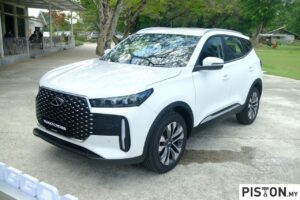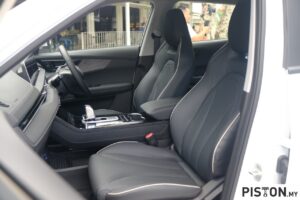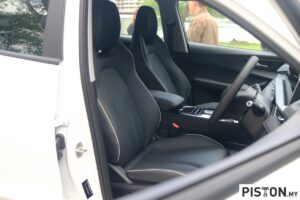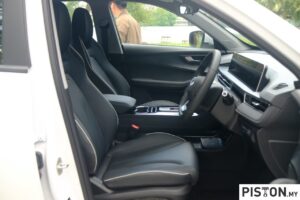Chery Auto Malaysia is stepping up its game with the launch of the Tiggo Cross, offering Malaysian consumers two compelling powertrain options – a 1.5-litre turbocharged petrol engine and a 1.5-litre hybrid (CSH). Both variants present a modern blend of technology, comfort, and safety aimed at value-conscious buyers without compromising on premium features.
The Tiggo Cross 1.5 Turbo is powered by a 1.5-litre petrol engine producing 147PS and 210Nm of torque, paired with a 6-speed Dual Clutch Transmission (DCT). This variant boasts a respectable 0–100 km/h time of 10.3 seconds in Sport mode and fuel consumption rated at 6.3L/100km.
Meanwhile, the Tiggo Cross 1.5 Hybrid CSH integrates a petrol engine with electric motors, delivering a combined output of 204PS and 310Nm of torque. It is more efficient with a fuel consumption figure of 5.4L/100km and a quicker acceleration time of 8.9 seconds. The hybrid model uses a DHT150 transmission with electronic shift-by-wire functionality.
This advanced CSH system delivers a smooth, fuel-efficient, and responsive drive — perfect
for both urban journeys and long-distance travel up to 1,000km mileage range.
Both variants share the same dimensions: 4318mm long, 1830mm wide, and 1670mm tall, riding on a 2610mm wheelbase, roughly the same size as a Proton X50. The suspension system comprises a MacPherson strut setup at the front and a torsion beam at the rear, with ventilated disc brakes at the front and solid discs at the rear.
Inside, the Tiggo Cross comes equipped with faux leather seats, dual-zone automatic air conditioning with rear vents, and a multifunction leather steering wheel. Both models feature front and rear armrests, ambient lighting, a wireless charger, a keyless entry system, remote engine start, and soft-touch materials across the dashboard.
The driver’s seat is electrically adjustable with lumbar support, while the co-driver’s seat is manually adjustable. Rear seats split 60:40 and offer three headrests. A total of three USB ports (two front, one rear) come as standard.
The dashboard features a dual-screen setup comprising a 10.25-inch digital driver display and a 10.25-inch infotainment head unit, supporting wireless Apple CarPlay and Android Auto. Other highlights include Bluetooth connectivity, a 540° HD panoramic camera system, an intelligent voice assistant, and a 6-speaker audio system.
Design-wise, both models are outfitted with LED headlights, daytime running lights (DRLs), tail lamps, fog lights, roof rails, and a rear sport spoiler. The cars sit on stylish 18-inch alloy wheels with red brake callipers for a sporty touch. Automatic headlights and a “Follow Me Home” function further enhance the vehicle’s practicality and style.
Chery prioritises safety with both variants receiving Electronic Stability Program (ESP), Brake Assist System (BAS), Hill Start Assist Control (HAC), Traction Control System (TCS), Emergency Brake Assist (EBA), and a Tyre Pressure Monitoring System (TPMS). The Turbo variant comes with 6 airbags, while the Hybrid version is upgraded to 7.
The Hybrid CSH model stands out with its extended Advanced Driving Assistance System (ADAS) suite, which enhances safety and driving convenience. This includes Adaptive Cruise Control (ACC), Lane Departure Prevention (LDP), Lane Keep Assist (ELK), Forward Collision Warning (FCW), and Autonomous Emergency Braking (AEB). Additional features such as Integrated Cruise Control (ICC), Traffic Jam Assist (TJA), Smart Speed Assist (ISA), and Multi-Collision Brake (MCB) further elevate its intelligent driving capabilities.
In contrast, the Turbo model offers a decent level of driver assistance, such as Blind Spot Detection, Lane Departure Warning, Door Opening Warning, and Rear Cross Traffic Alert with Braking.
Both models come in Carbon Black, Phantom Grey, and Khaki White, with the 1.5 Turbo also offered in Blood Stone Red, while the Hybrid CSH adds Moonlight Silver as an exclusive colour option.
Each variant includes a standard warranty of seven years or up to 150,000km. However, the 1.5L Hybrid CSH extends its coverage with an additional eight-year warranty or up to 160,000 kilometres specifically for the battery power pack, power motor, and hybrid control unit. Both models also come with seven years of complimentary towing service.
Pricing starts from RM88,800 for the 1.5 turbo and RM99,800 for the 1.5 Hybrid CSH. The early bird package consists of two years all inclusive free service.
The Chery Tiggo Cross offers a compelling package, whether you prefer the responsive petrol-powered 1.5 Turbo or the high-efficiency 1.5 Hybrid CSH. With generous features, an advanced safety suite, and striking styling, it stands out as a serious contender in the compact SUV segment in Malaysia.






















































































































































